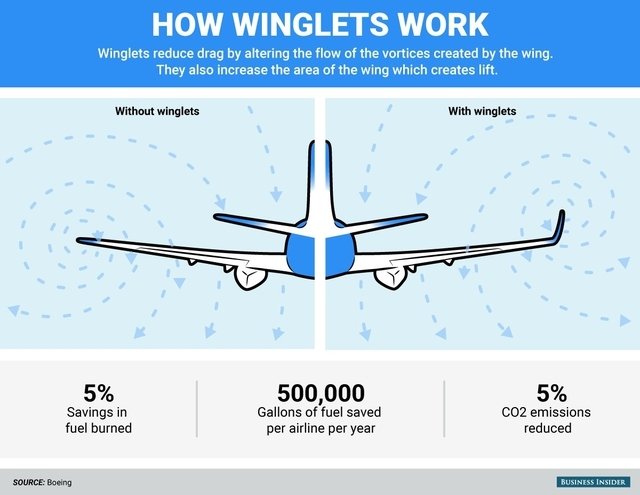
Canted winglets are short, upward-facing wings.
Robert Gregg – Head of Boeing’s aerodynamics department, once shared with Business Insider that, `Winglets will help reduce vortex flow at the wing tips, contributing to increasing lift for the aircraft.`
Thanks to the efficiency in the process of creating lift force and reducing air resistance, the aircraft engine will work a little less.
According to Boeing, this type of winglet installed on its 757 and 767 aircraft can cut CO2 emissions by up to 5% by optimizing fuel burning efficiency by up to 5%.
Explaining more specifically the effect of this small wing, Business Insider said: When an airplane is flying, the air pressure above each wing will be lower than below, creating a difference.
These vortices move in three dimensions along the wingspan.
With the introduction of glider wings, aircraft can weaken the effects of wingtip vortices and, more importantly, it will reduce the drag acting on the entire wing.
According to Robert Gregg, designing longer airplane wings is also a solution to overcome that problem.
Therefore, winglet becomes the optimal solution chosen by Boeing to apply to small commercial aircraft.
Winglets were first invented in 1976, by Richard Whitcomb at NASA’s Langley Research Center.

The head of Boeing’s aerodynamics department said that the first generation gliders often associated with aircraft such as the Boeing 747 – 400 and McDonnell Douglas MD11 helped save 2.5% – 3% of fuel.
By the second generation, the winglet was larger in size than the first generation with a larger curvature, equipped for Boeing 737, 757 and 767, contributing to fuel savings from 4% to 6%.
Boeing’s 737 Max equipped with third-generation winglets has increased fuel economy by up to 5% to 8%, 1 to 2% more than the previous generation.
Source: Business Insider, Techinsider








